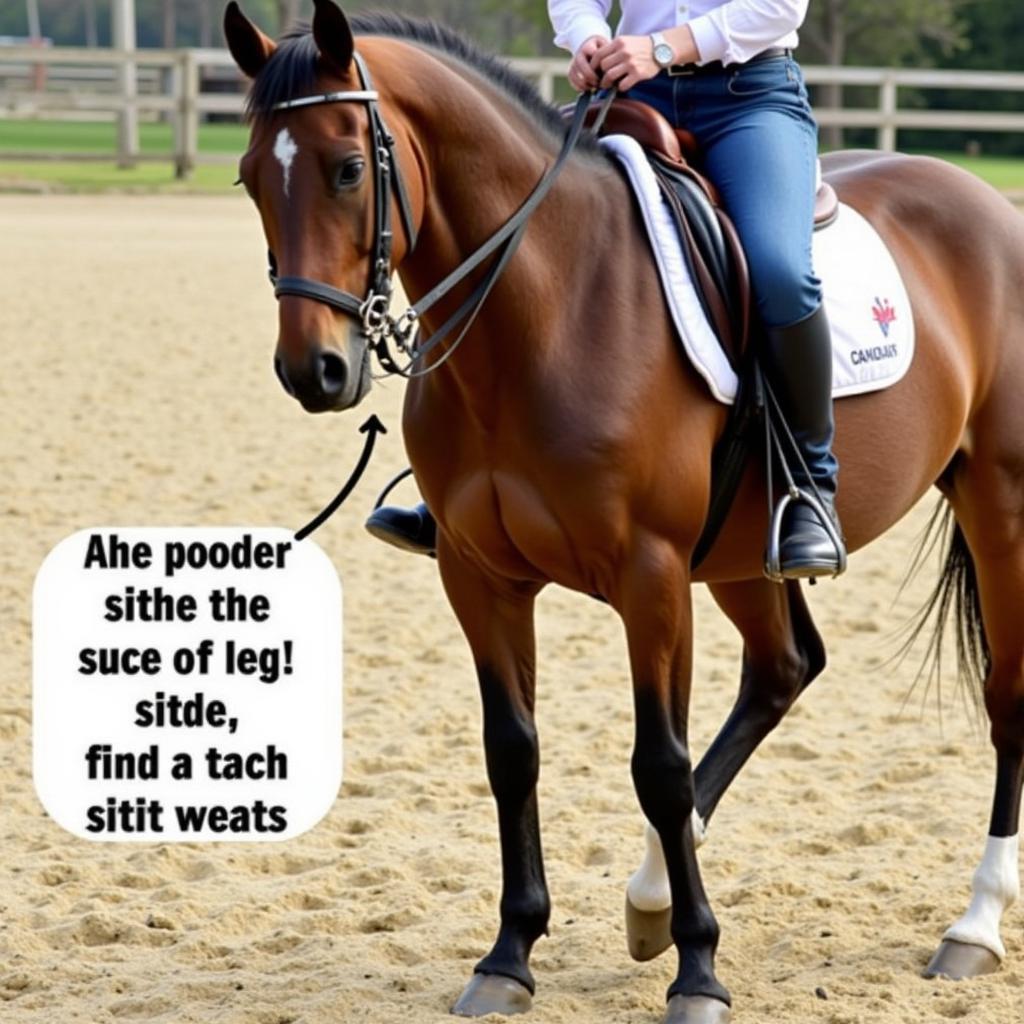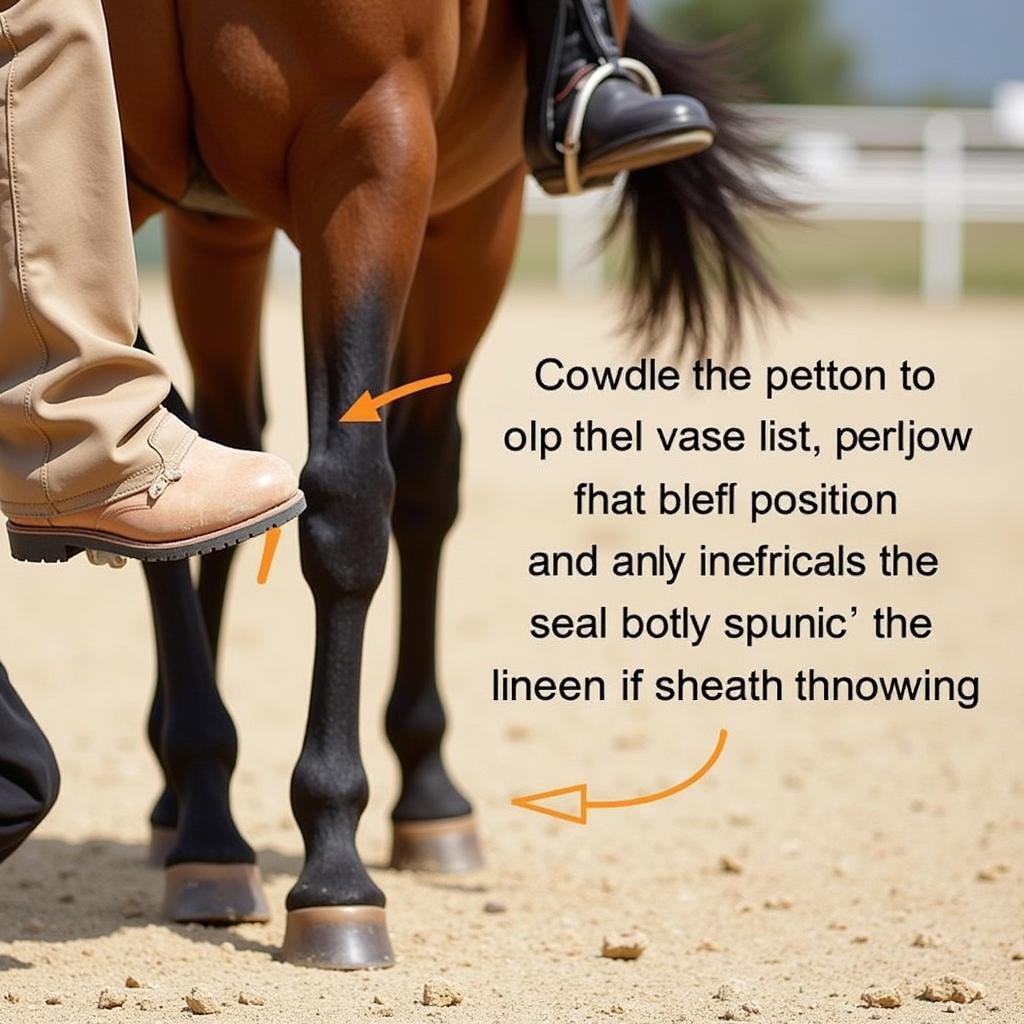Spurs For Horse Riding are tools used to refine communication between rider and horse. They’re not meant for punishment, but rather as an aid for more precise cues. Choosing the right spurs, understanding their purpose, and using them correctly is crucial for effective and ethical riding.  Rider Demonstrating Proper Spur Usage
Rider Demonstrating Proper Spur Usage
Types of Spurs for Horse Riding
Various spurs cater to different riding disciplines and rider preferences. Understanding these variations is key to selecting the appropriate spur for your needs. Common types include:
- Prince of Wales Spurs: These feature a small, rounded knob at the end. They are considered relatively mild and are often used by beginners.
- Ball End Spurs: Similar to Prince of Wales spurs, but with a slightly larger, ball-shaped end. They offer a bit more pressure.
- Rowel Spurs: These spurs have a small, rotating wheel at the end. The action of the rowel can be quite sharp, and their use requires experience and careful control.
- Hammerhead Spurs: Featuring a flat, blunt end, these spurs deliver a wider area of pressure.
How to Choose the Right Spurs for Horse
Choosing the correct spurs requires considering several factors: your riding discipline, experience level, and your horse’s sensitivity. horse spurs and straps are essential for any rider.
- Discipline: Certain disciplines, like Western riding, often employ spurs with rowels, while English disciplines may favor smoother spurs.
- Experience: Beginners should start with milder spurs like Prince of Wales or ball end spurs.
- Horse’s Sensitivity: A sensitive horse may respond well to a lighter touch, while a less responsive horse might require a slightly more assertive spur.
Using Spurs for Horse Riding Correctly
Spurs for horse riding should never be used to punish or inflict pain. They are a refinement of the leg aid, used to give more specific cues. spurs for horse should be used with precision and care.
- Leg Position: Maintain a correct leg position with your heel slightly down.
- Timing: Apply the spur simultaneously with the leg aid, not as a separate action.
- Pressure: Use the lightest touch possible to achieve the desired response.
- Release: Immediately release the pressure once the horse responds.
Common Mistakes to Avoid with Spurs
Many riders, especially beginners, make common mistakes when using spurs for horse riding. These errors can lead to confusion for the horse and potential harm.
- Jabbing or Kicking: Spurs are not for kicking or jabbing the horse.
- Overuse: Using spurs constantly can desensitize the horse.
- Incorrect Leg Position: A poor leg position can lead to unintentional spur contact.
“Spurs are an extension of your leg, not a weapon,” says renowned equestrian trainer, Amelia Cartwright. “They should be used with finesse and understanding.”
 Correct Leg Position with Spurs
Correct Leg Position with Spurs
Caring for Your Spurs
Proper care and maintenance of your spurs for horse riding will ensure their longevity and functionality. ride the right horse is crucial for both horse and rider.
- Cleaning: Regularly clean your spurs to remove dirt and debris.
- Storage: Store your spurs in a dry place to prevent rust.
- Inspection: Periodically inspect your spurs for any damage or wear.
When Not to Use Spurs
Spurs are not always necessary. There are situations where their use might be counterproductive or even harmful. how to cue a horse for the correct lead can be accomplished without spurs.
- Beginners: Very new riders should focus on developing their basic leg aids before using spurs.
- Young or Sensitive Horses: These horses can easily become overwhelmed by the use of spurs.
- Disciplines Where Spurs Are Not Allowed: Check the rules and regulations of your specific discipline.
“Remember,” advises experienced riding instructor, Johnathan Davis, “the goal is to communicate clearly with your horse. Spurs should be used to refine that communication, not to force it.”
In conclusion, spurs for horse riding can be a valuable tool for experienced riders, allowing for more subtle and precise cues. However, they must be used responsibly and with a deep understanding of their purpose. Choosing the right spurs and employing them correctly will enhance communication with your horse and contribute to a more harmonious riding experience. horse riding show clothes can be found on our website.
FAQ
- What are spurs used for in horse riding? Spurs are used to refine leg aids and give more precise cues to the horse.
- What type of spurs should a beginner use? Beginners should start with milder spurs like Prince of Wales or ball end spurs.
- Are spurs cruel? Spurs are not inherently cruel, but they can be misused. Correct usage is crucial.
- How do I clean my spurs? Clean your spurs regularly with a damp cloth and mild soap. Dry them thoroughly to prevent rust.
- Can I use spurs on a young horse? It’s generally recommended to avoid using spurs on very young or sensitive horses.
- When should I not use spurs? Avoid using spurs if you are a beginner, if your horse is young or sensitive, or in disciplines where they are not allowed.
- What is the purpose of different spur types? Different spur types offer varying levels of pressure and are designed for different disciplines and riding styles.
Need support? Contact us 24/7: Phone: 0772127271, Email: [email protected] or visit us at QGM2+WX2, Vị Trung, Vị Thuỷ, Hậu Giang, Việt Nam.